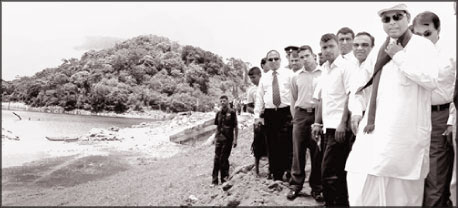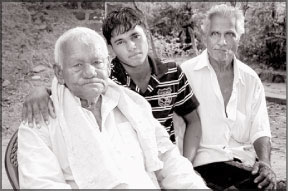Reviving Lanka’s ancient glory
Repairing tanks brings new life to Trinco :
Dharman Wickremaratne
New lease of life
|
*Two thousand tanks to be rehabilitated in 17 districts
*First stage - Rs 200 m to repair 25 tanks
*Second stage - 27 tanks
*No of small tanks in Dry, Wet Zones - 12,000
*No of rural tanks - 20,000
|
The sun over the Thambalagamuwa Secretariat Division in the
Trincomalee district appears brighter than before. The hitherto
drab-looking village of Galmitiyawa South seems to have got a new lease
of life after steps were taken to repair the Kudagalmitiyawa tank.
During the course of this year, 25 tanks in the Trincomalee district
have been selected for repairs at a cost of Rs 200 million. Twenty-seven
more tanks will be repaired under the second stage of this project in
2012. The ceremony inaugurating the project to repair a total of 52
tanks was held near the Kudagalmitiyawa tank on April 22.
In the coming years 2,000 tanks will be repaired under Economic
Development Minister Basil Rajapaksa’s direction in accordance with
Mahinda Chinthana. Most of these tanks had not been repaired for
hundreds of years. They include those the Portuguese destroyed over four
centuries ago. The floods of December, January and February severely
damaged some of these tanks.
Development schemes
The legends associated with them are many. The Trincomalee district
is one of the areas symbolizing this unique heritage of Sri Lanka which
was known in ancient times as a kingdom of tanks. Previous governments
were focused almost entirely on launching giant development schemes as
the Mahaweli. Hardly any attention was paid to complaints of farmers
whose livelihood was linked to the ancient tanks and irrigation
channels. Now, Minister Basil Rajapaksa has raised their hopes as never
before. The minister’s efforts towards making rural communities
beneficiaries of the government’s development policies are now bearing
fruit. Foreign invasions and pernicious policies of foreign rule
destroyed many tanks, which were like the nation’s soul. The jungle
crept over a greater number of breached tanks. According to the
agro-based ancient culture the tanks fell into three categories - the
smallest was the Gaamika wewa, which served a single village. The medium
was the Daana wewa which catered to several villages while the largest
was the Maha wewa which covered a large area known as a koralaya - a
division of a province.
|

Minister Basil Rajapaksa giving instructions about repairs
to the tank |
The Economic Development Ministry and the Agrarian Services and
Wildlife Ministry are jointly repairing 2,000 tanks in 17 districts.
This programme was inaugurated at Mahakalugolla village in the
Siyambalanduwa Divisional Secretariat, Moneragala District on February
7. It commenced with a ceremony to repair the Kivuleara wewa. Already
repair work is underway in seven districts - Moneragala, Anuradhapura,
Batticaloa, Ampara, Mulaitivu, Puttalam and Trincomalee. Repairs to
tanks in the remaining 10 districts of Mannar, Polonnaruwa and Vavuniya
will begin in the next few days. Project director of the Economic
Development Ministry’s Yali Pibidemu (Reawakening project), S K Liyanage
- an engineer by profession - is directing all the repair work done by
hundreds of workers who appears like a beehive trying to meet the
deadlines.
Historical sources
The following day we were at the Kantale tank bund. Many historical
sources state King Agbo II (604-615 AD) had built this tank. But
according to a book R L Brohier wrote it was King Mahasen (274-305 AD)
was the builder. This was told to us by Pathmasiri Jayasekera, Executive
Officer of the Livestock and Rural Community Development Ministry, when
we were walking along the tank bund. A great calamity occurred when the
Kantale dam burst on April 20, 1986 causing the deaths of 178 people and
destroying 20,000 acres of paddy land. When we visited the place there
was not even a trace of the 300 odd houses that were swept away in that
disaster. The total cost of repairs to the Kudagalmitiyawa tank in the
Thambalagamuwa Secretariat Division, Trincomalee is Rs 19 million.
Arable land in the area is 140 acres and the beneficiaries after
completion will be 130 families. The work is scheduled to be completed
before October 21, according to Assistant Engineer T Raghunathan.
Wearing a straw hat he looked like a Vietcong soldier who fought against
American troops in the Vietnam War. It is sad to see the tank full of
silt in its present condition although at one time it channeled water to
a large area of paddy land through three sluices.
Paddy cultivation
Galmitiyawa South belonging to the Seruwila seat is home to around
1,200 families whose chief livelihood is paddy cultivation.
Kudagalmitiyawa tank gets water from the Mahagalmitiyawa tank into which
water flows from streams in the surrounding hills and the Morawewa tank
across which a dam has been built for the purpose.
|

Senior most farmers Punchibanda and Mithrapala with grandson
Kumara |
The floods of February this year destroyed the dam and inundated the
village. Two persons drowned in the six feet deep floodwaters. One of
the victims, H M Tikiri Banda (45), died while doing some minor repairs
to the dam. This was told to us by his younger brother Ajith Kumara (36)
when we met him at his house. He and his mother Koyin Menika is
expressed joy at seeing the bund being repaired at last and without
delay.
Nearly 9,000 small tanks have been identified in Sri Lanka’s Dry Zone
while the West Zone has only about 3,000 of them. Altogether there are
20,000 rural tanks, including those that have been abandoned. If water
can be supplied from all these tanks, a total of around 175,000 hectares
of paddy land can be cultivated. This makes it clear the extent to which
these tanks contributed to the country’s prosperity and agro-based
civilization in ancient times. Minister Basil Rajapaksa is a
result-oriented politician up with the challenge of economic development
in many spheres. He believes in innovation to broaden ownership to the
participation of the people in development.
National income
Agriculture occupies the most important position in Sri Lanka’s
economy. It contributes to 25 percent of the gross national income.
Fifty percent of the population is employed in the agricultural sector.
Since 80 percent of the people are in the rural areas the country needs
to obtain the maximum benefit from agriculture. Sixteen fishermen make a
living from the Galmitiyawa tank and they have formed a fishery society
to look after their interests. After the floods destroyed the tank they
have not been able to do any fishing. All the different species of
freshwater fish have perished. We met one of the fishermen, Samantha
Rupasinghe (38) a father of two children - Lahiru Dilshan (12) and
Rukshan (3). Lahiru is a student of Mollipathana school. The work
undertaken to repair the tank has raised Rupasinghe’s hopes for a bright
future for his sons.
Heavy rains and floods caused extensive damage to the Puttalama,
Anuradhapura, Polonnaruwa, Batticaloa, Trincomalee and Ampara districts.
Never before had farmers in these areas faced such suffering. Only three
times - 1878, 1913 and 1957 - Sri Lanka had experienced devastating
floods, previously. They destroyed all tanks farmlands, irrigation
channels and thousands of homes, causing many deaths. About 300,000
people were displaced. The loss to the agro-economy was incalculable.
Irrigation channels
We met Kekulandara Mudiyanselage Punchibanda (81), the senior most
farmer of Mollipatahana Village, Galmitiyawa South. He is a father of
six and has 18 grandchildren. He is the real creator of the
Kudagalmitiyawa tank the story of which he recalled along with his wife
Dingier and grandson Canada Kumara. To Punchibanda those early days are
a fond memory.
Punchibanda who hails from Hanguranketha was first appointed to work
on irrigation channels in Hingurakgoda. From there he had come to
Kantale in 1951 when a day’s wage was Rs 8. In 1956 the Government
Agent, provided 312 families with blocks of land of two-and-a-half acres
each under the Mahaweli System. Punchibanda had settled in Kantale in
1958 when he and others came to know that the Parepannam tank was being
newly built.
The villagers immediately rushed to Colombo and met Minister C P de
Silva. Eight of them went in a lorry belonging to Wilson Mudalali of
colony 96 since they could not afford the bus fare of Rs 6. As a result
of their meeting with the Minister, he ordered his officials to start
repairing the Mahagalmitiyawa tank as soon as the work on Parepannam
tank was finished. Accordingly, the Mahagalmitiyawa tank was completed
in 1962. This story was related by Ediriweera Patabendige Mithrapala
(76), a senior farmer who came to Trincomalee from Weligama in 1948.
The history of Kudagamitiyawa tank begins in 1972. Punchibanda - the
man behind it - says that having seen the continuous flow of streams
from the hills he built an anicut eight feet long and 200 meters long.
It provided water for cultivating four acres of paddy land during
September.
Although many letters were written to the authorities since 1977
urging them and various top politicians to make the anicut a tank, the
appeals were not heeded. Eventually help came in the form of Irrigation
Engineer who came to repair the Kantale Dam in 1986. After repairing the
dam he and his workers, using the machinery they had brought, completed
the Kudagalmitiyawa tank in 48 days. As the number of paddy lands began
to expand the water supply became insufficient. Although water levels in
the tank were raised there was no water management causing various
problems. Finally the floods in February completely destroyed the tank.
The inclusion of Kudagalmitiyawa in the list of 2,000 tanks selected for
repairs is the realization of a dream.
Poverty is the biggest challenge mankind faces today. There is no
doubt that the programme to repair 2,000 tanks Economic Development
Minister Basil Rajapaksa has initiated in accordance with the Mahinda
Chinthana will go a long way in overcoming poverty in the rural areas.
[email protected]
|



